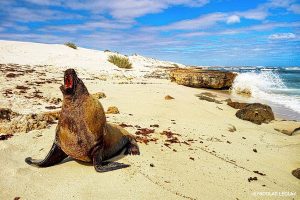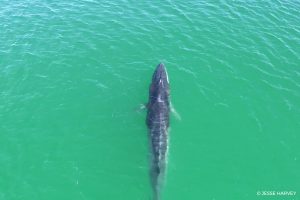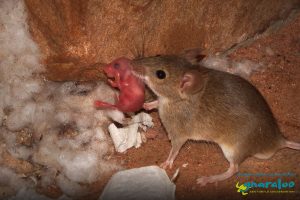Short-beaked Echidna
Tachyglossus aculeatus
Photo by Melissa Tan, 2014
The short-beaked echidna is an Australian favourite and the oldest surviving mammal. Echidnas are monotremes, meaning they are one of only 2 mammals that lay eggs. They have two types of fur that covers their body, a coat of short hair that insulates the echidna and long hairs that act as spikes, protecting them from predators. Baby echidna’s are called puggles and hatch from the egg by using an egg tooth. Once the puggle is hatched it attaches itself to a milk patch inside the female echidna’s pouch and nurses for 8-12 weeks or until the spines fully develop. Parental care stops after 200 days and the puggle reaches sexual maturity after about 5 years.
Humpback Whale
Megaptera novaeangliae
Photo by Ose Nissen, 2017
Humpback whales migrate annually from feeding grounds in the Antarctic to breeding grounds in warm tropical waters, such as off North Western Australia. They pass by Gnaraloo from July to October, often engaging in spectacular displays breaching the water and slapping their pectoral fins. They are easily distinguished from other whales by their long, knobbly fins (up to 5 m) which may be a third of their body length. The humpback whale is a species of baleen whale which means it has no teeth; instead, it feeds by taking an enormous gulp of water and straining zooplankton out of the water through its baleen, which are the bristly, comb-like plates hanging from the top of its palate.
Common Wallaroo (Euro)
Macropus robustus
Photo by Claire Guillaume, 2013
Gnaraloo is home to a multitude of common wallaroos, locally referred to as Euros. Wallaroos are closely related to kangaroos and live throughout most of mainland Australia. Their colour is highly variable, shifting from dark grey in the East to rusty red in WA. They are most likely to be found foraging alone or sometimes with other family members. They are opportunistic breeders, meaning that they can breed throughout the year, instead of a set mating season, as long as they have access to essential resources, such as water. During the day, these wallaroos can often be found hiding under shade to escape the relentless sun.
Finlayson’s Cave Bat
Vespadelus finlaysoni
Photo by Simone Bosshard, 2017
Finlayson’s cave bats are commonly found in abandoned mine shafts or rocky outcrops. Recognized only 30 years ago, these bats are now known to have the broadest geographic range of cave bats and can be found from the deserts of central Australia to the tropical northern regions of the country. Cave bats are often found in single colonies exceeding 500 individuals. Not much is known about the breeding behaviour of this species, but among colonies in the Northern Territory, females may breed twice a year and nearly 20 percent of offspring are twins.
Australian Sea Lion
Neophoca cinerea
Photo by Nicolas Leglay, 2017
Australian sea lions are endemic, meaning they can only be found along the beaches and waters of Australia. They can be found in in South Australia and Western Australia living together in small populations, often genetically isolated from one another. They are sexually dimorphic, with the males being larger than the females. Mature females breed once every 18 months, instead of the typical annual breeding, making them unique among pinnipeds. Their small population sizes make them more susceptible to changes in population growth and more vulnerable to risks. Historically hunted for their fur, Australian sea lions are now listed as an Endangered species by the IUCN Red List. Today they are mainly threated by the fishing industry and being a bycatch in gillnets.
Spinifex Hopping-Mouse
Notomys alexis
Photo by Claire Guillaume, 2016
The spinifex hopping-mouse is a keystone species, meaning it can be used as an indicator of biodiversity health. It inhabits the arid zones throughout central and Western Australia, occupying both spinifex-covered sand flats and stabilised sand dunes. Spinifex hopping-mice are nocturnal and stay hidden during the heat of the day. Like many other desert mammals, they can survive without drinking and obtain sufficient amounts of water from their diet of seeds, roots, and insects.
Have you seen animals that are not listed here?
Please submit your photos of what you saw at Gnaraloo – on land or in water – with a species identification.








